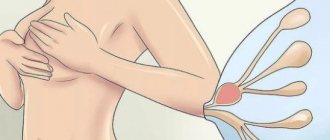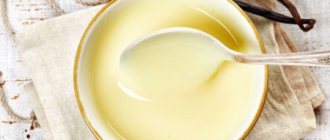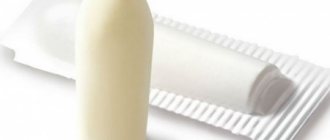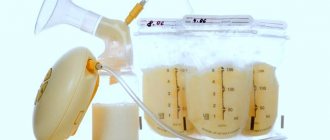Breast milk is the basic need of a newborn baby. For successful breastfeeding, it is necessary to closely monitor the condition of the mammary glands. At different stages of the child’s growing up, they work taking into account the baby’s needs; the composition of the milk also changes. At the very beginning of lactation, it is imperative to massage the breasts during feeding. In a later period, it will help to avoid problems and increase the amount of milk.
When inflammation in the chest has already begun
There is another option, when no obvious compaction can be felt, but there is pain and redness on the skin.
This may be galactophoritis, that is, inflammation in the duct. Redness over the sore area indicates the onset of inflammation. There is very little stagnant milk, and it is not in lobes, but in the duct.
Such inflammations are the most dangerous, because they develop unnoticed and do not immediately make themselves felt. Already in the first day after the problem is discovered, there may be altered milk: bright yellow, thick, like butter or jelly.
“Jelified milk” is also a sign of inflammation. This is no longer just stagnation of milk, we are talking about mastitis!
Normal lactostasis, when milk accumulates in the milk lobe, can turn into mastitis after 3 days. But they rarely last that long.
Another sign of inflammation may be increased body temperature. But quite often, intense heat accompanies stagnation from the moment it occurs. Because protein from milk enters the blood.
With inflammation, the temperature can stay at a little over 37. And this is just a bad symptom.
The temperature returns to normal within several hours or one day after the stagnant lobes are emptied.
Fever is not a contraindication to breastfeeding! And a child cannot be “poisoned” by milk if inflammatory processes have already begun. This is exactly what the World Health Organization has been trying to convey to doctors for 19 years in its manual “Mastitis. Causes and Management" (2000)!
But it can get much worse for mom if she stops feeding!
But first things first.
What is this lactostasis and why does it appear?
Congestion occurs when milk flow is disrupted in some part of the breast. A milk plug is formed, which blocks the exit of newly formed milk; in place of this plug, swelling of the breast tissue occurs, which makes itself felt first by compaction, and then by soreness, redness and a rise in temperature.
Causes of lactostasis:
- feeding in the same position, with the same breast;
- pumping after each feeding (when there is no stagnation, pump only if you feel excessive fullness to a state of lightness, i.e. not completely);
- insufficient water consumption, especially in summer;
- hypothermia;
- unsuitable underwear that compresses the breasts;
- excessive physical stress on the hands;
- lack of sleep and general fatigue;
- even weather changes can be a cause.
If lumps appeared, the chest and fever began to hurt. Here's my recipe:
1. Do a massage. We support the breast with our left hand, squeeze baby cream or oil onto the right hand and with sliding circular movements (light, without pressing!) massage the breast towards the nipple, as if expelling milk. The whole trick is in the cream! From such a massage the streams flow from me. We alternately massage the right and left breasts. It is better to strain the patient completely, healthy until a feeling of lightness is felt.
2. Get into a warm shower (not hot!), direct the water to the area with the bump and, pressing the areola slightly inward, express the milk. We pump the sore breast until it becomes completely soft, like a “rag”.
3. Folklore: cabbage leaves help to dissolve cones very well. First you need to beat it a little and freeze it so that the juice is soft and easily released. We apply it after we have completely pumped the sore breast. Leave until it becomes dry, i.e. will give away all the juice. A friend recently saved herself with a honey cake and applied it at night for several days in a row.
4. If possible, you should contact an experienced consultant
on breastfeeding, which will help you pump your breasts and not waste time.
Do not heat
under any circumstances !!! And don't wrinkle !!!
You can make it even worse and lactostasis will turn into mastitis!
6. Be sure to feed the baby with a sore breast
, no one can say it better than him. You can try changing the feeding position so that the baby’s chin points to the location of the bump, i.e. if the congestion is closer to the armpit, feed in the “under-arm” position.
Now my lactation is established, the baby sleeps either 3 or 5 hours at night, the breasts become full and hard, but no lumps form, he drinks everything completely and I don’t pump at all. I control the volume of milk with the liquid I drink.
As for lactostasis, almost every nursing mother goes through this; this can only be avoided by manually expressing the breasts to a state of lightness in the first weeks! and prevent overflow, i.e. If you feel that your breasts have already begun to harden and it’s not too soon to feed, you can express a little. But you also need to understand that the amount of milk is produced on demand, the greater the demand, the greater the supply. If you get used to pumping constantly, then you will have to do it always.
Causes of pathology
Stagnation of milk in the breast is not a disease, but a condition in which constantly arriving milk clogs one or more ducts - the so-called milk plug. This causes severe discomfort, which forces some women to even give up feeding their baby in favor of artificial formula.
The occurrence of lactostasis is possible at any stage of breastfeeding, but more often it occurs in the first three weeks after birth, after the end of colostrum production. Then the milk begins to actively flow, but the breasts are not ready for this or the woman is not caring for it correctly.
A sudden flow of milk leads to breast enlargement, often accompanied by pain, the appearance of lumps, and an increase in temperature.
The causes of lactostasis begin in the period before childbirth and in the first weeks of feeding; there are also physiological reasons:
- the woman did not develop her breasts before childbirth;
- milky passages are narrow and short in length;
- flat nipple;
- endocrine disorders;
- mammary gland injuries;
- infrequent breastfeeding;
- the woman herself provokes stagnation by constantly squeezing her breasts in one place during feeding;
- short feeding time from one breast;
- sleeping on your stomach;
- long breaks between feedings (more than 7-8 hours);
- mother's overwork;
- uncomfortable bra;
- expressing the breast until it is completely empty, which causes a sudden supply of new milk, which the baby cannot eat.
But the most important and common reason is the baby’s incorrect attachment to the breast from the first feedings. If a child does not grasp the nipple correctly, then he sucks milk from the same ducts, and some remain inactive, which causes stagnation and blockage of the passages.
To get stagnant milk to circulate, there are several methods that are best used in combination:
- learn how to properly attach the baby, taking into account the place where the stagnation occurred;
- proper expression of leftovers after feeding;
- massage for lactostasis;
- physio- and water treatments;
- correct drinking regime;
- comfortable underwear;
- prevention of lactostasis.
Rules of procedure
For the procedure to be effective, it must follow certain rules:
- Massage before feeding your baby or before pumping.
- Movements during the massage should be careful and smooth. Aggressive, intense movements can harm the glands.
- Use a rich cream or neutral oil during the procedure to avoid skin injury.
- Follow the direction from the edge of the breast to the nipple.
- The massage should cover the entire mammary gland and armpits.
- For severe chest pain, massage can be performed in a warm bath (37°C), which helps to relax the muscles.
If a woman has found hardening in the mammary glands, her temperature has risen, and her general health has worsened, then you should not hope that the discomfort will go away on its own. It is necessary to begin proper breast massage during breastfeeding on your own, or with the help of relatives.
To get rid of the uncomfortable condition, normalize the production and flow of milk, you need to properly prepare for the procedure:
- You need to wash your hands well and trim your nails short. To increase lactation during breast massage, it is recommended to prepare a special mixture. You will need vegetable oil (1 tsp) and a drop of sage oil. During the procedure, you need to use a rich massage cream to prevent damage to the delicate skin. Hands also need to be lubricated with cream to enhance the relaxing effect of the procedure;
- One of the main conditions for successful breast massage for lactation is a relaxed state of the muscles during the session.
Important: breast massage during feeding should be done before the baby is applied to the nipple, and after. This will make pain and other stagnant symptoms go away faster.
During the procedure, pain must be eliminated. Rough, sudden movements are unacceptable.
To get the expected result, you need to know how to massage your breasts while breastfeeding. The technique for performing the procedure consists of the following mandatory manipulations:
stroking. The session begins with these movements. Manipulations are performed from the edge of the glands and directed towards the central part in a clockwise direction; Spiral manipulations are performed in a circle, each section of the gland and the axillary region are treated. The main movements should be directed to compacted areas where milk has stagnated. Manipulations go from the sides up and to the center, then down and to the lateral parts of the gland
It is important to observe the correct direction of movement - from the sides to the center of the nipple; each seal must be processed separately and carefully, clockwise; tapping manipulations should be done over the entire surface of the gland, simultaneously with light pressure. The direction of manipulation is from the edge of the glands to the center; at the end of the procedure, you need to shake your chest a little, leaning forward
If breast massage for milk flow causes severe pain, then you can massage the problem areas in the shower. Standing under warm streams of water in the shower, a hydromassage technique is used. The shower is directed to problem areas in a clockwise direction, from the peripheral areas to the nipple. The duration of water manipulations is 15 minutes. As a result, the ducts relax and outflow normalizes.
Important: when breast massage is performed before feeding, you need to feed the baby, or be sure to express milk. If there is no improvement, pain remains, and the temperature persists for more than 3 days, then you should definitely seek medical help.
Stagnation in the glands that does not go away for more than 4 days leads to an inflammatory process - mastitis. The advanced condition can be eliminated only by surgical intervention.
It happens that independent breast massage before and after feeding does not give results. In this case, after seeking medical help, a professional breast massage for milk is prescribed.
You need to understand that the procedure for normalizing blood pressure consists of complex measures. Between breast massage sessions, pumping and feeding are required to ensure the milk arrives. The massage procedure eliminates compactions in the glands. But, if milk residues remain in the glands, then the bumps appear again.
Rules for breast massage during breastfeeding
To get a quality breast massage, you don’t have to turn to specialists. You can master a simple technique at home by following the general rules:
- Before the procedure, you need to wash your hands and wipe them dry with a towel so that the skin of your hands is not wet and cold. You can lubricate your palms with olive or castor oil. The main thing is that it does not get on the nipples and areolas.
- Breasts can be washed with soap no more than once a day. Detergents dry out the skin (especially tender nipples). As a result, they are easily injured either by the child or by the mother herself. An unjustified struggle to keep the breast clean leads to the washing away of protective bacteria, which will leave the skin open and defenseless to infectious agents.
- You need to choose a comfortable position (15 feeding positions). Place a pillow or bolster under your back. It is better to massage in front of a mirror. If mommy loves music, turn on her favorite tune.
- You can help the milk flow when feeding if the baby sucks unproductively and does not eat enough. After taking a short break during the feeding process, mommy can run her palm around the breast several times. This will allow the ducts to relax more and allow milk to be released more intensively.
- Before pumping, it is advisable to massage in the shower, directing a stream of warm water to the breast, and then make light stroking movements.
Important! Whatever the massage for hepatitis B - preventive or therapeutic, there should be no chest pain. Otherwise, the opposite effect will occur, and the desired emptying of the ducts will not be achieved. All movements are made smoothly, carefully, softly. The massage on each breast should not take more than 5 minutes .
Preventive massage technique for breastfeeding:
- The palm lubricated with baby cream or oil is placed slightly below the collarbone. The second palm is placed under the chest;
- make smooth circular movements, gradually descending towards the nipple;
- perform simple stroking along the décolleté area from top to bottom;
- shake the chest in a slightly downward position. This will increase milk flow;
- You can lightly pull, rotate, or squeeze the nipples with your fingers as a warm-up. This will help avoid cracks and wounds;
- all movements are carried out towards the nipple from the base of the mammary glands
After the procedure, the flow will increase: the baby can be put to the breast or start pumping. Not only massage of the mammary glands, but also massage of the back and cervical region will help improve pumping. To do this, you can use the help of loved ones. It is important that the massage is carried out not on the stomach, but while sitting. Squeezing during breastfeeding is unacceptable. If a nursing mother wants to have a back massage from a specialist, it is necessary to express both breasts before the session in order to avoid milk leakage.
Massage for milk stagnation
Medical procedures should not be done without a doctor's testimony. It is better to consult before doing a massage yourself. Inept handling of problem breasts in which lactostasis has formed can lead to unpleasant complications.
Typically, massage during milk stagnation is carried out according to the following scheme:
- Perform regular stroking of the chest with your palms (palms should be warm and dry);
- With moderate pressure on the chest, spiral movements are lowered from the collarbone to the nipple. Don't be afraid to make an effort. If milk stagnates, pressing or light tapping will not hurt. The main thing is that you don’t feel pain. Thick milk may come out of the breast - this means that the milk plug has come off and the duct is free. If this does not happen, there is no need to be upset. When feeding, the baby can draw out stagnant liquid;
- the nipple is massaged, but not squeezed;
- vigorously knead the inflamed nodes. The main thing is not to squeeze the milk out of them, but to soften the tissue so that when sucking or expressing, the milk can flow out without difficulty.
After the massage, take a warm shower, directing a stream of water to the chest. Pumping a little after feeding will clear clogged passages and reduce the size of nodules. But you don’t need to get carried away, otherwise the milk will come in excess. Expressing is allowed during the daytime and only for a few days in order to correct the unstable feeding system.
The main rule of breastfeeding, which helps to avoid lactostasis, is to frequently place the baby on the problematic breast and wear a comfortable, non-squeezing bra with wide straps.
How to express milk during stagnation?
If, despite all the steps taken, the baby still cannot cope with the resorption of stagnation, you need to try to express the milk yourself. In rare cases, even a breast pump may work.
But it’s more effective with your hands. However, there is no need to press with all your might on the stagnation. This is very painful and traumatizes the breast tissue. The World Health Organization does not recommend using this method in its materials!
The technique of pressing your fingers on the areola works great. It's called the Marmet pumping technique:
Place your fingertips on the border of the areola and white skin, in line with the nipple. For example, first from above and below the nipple. We press towards the ribs, and then begin to move our fingers towards each other and a little forward. Fingers should not slip on the skin! They should stand in one area and move with the breast tissue. There is also no need to pull the nipple forward. (See video at the end of the article). To enhance the effect with less pressure on the areola, you need to rest the base of the hand on the chest, and not keep your hand suspended.
To make pumping more effective, you should think about relaxing and drink a cup of warm drink first, or get under a warming shower - it is better to direct it not on the chest, but on the neck and back. You can also steam your feet.
Preparation
In order for breast massage to bring only benefits and a sea of positive emotions during its implementation, you need to prepare for it. First of all, it’s worth:
- pump your breasts. As an option, you can start doing massage after feeding the baby;
- wash your hands with soap;
- select additional means of influence. Traditionally, warm olive or castor oils are suitable, which can enhance the effect and have a beneficial effect on the overall condition of the breast. The main thing is not to apply them directly to the nipples;
- choose the most comfortable position. Ideally, you need to sit on a chair in front of a mirror in order to personally observe the correct execution of the technique.
And most importantly, you need to carefully monitor your own feelings. Any painful manifestations indicate that the massage is performed incorrectly and can simply cause harm.
Massage
The simplest and most accessible way to combat this pathological condition is pumping, either manually or using special mechanical devices - breast pumps.
This procedure is quite simple, but must be performed in accordance with certain rules and only after a breast massage session.
Massage is a mandatory stage of pumping during lactostasis, ensuring the most complete relaxation of the mammary gland, as a result of which milk moves much faster through its ducts.
It is important to remember: the massage before pumping is not intended to break the seal, but to relax the gland, so it must be carried out independently, gently and carefully. Rules:
Rules:
- Do not apply pressure or any other movements that cause or increase pain.
- The breasts are not kneaded, but rubbed and stroked, warming and relaxing them.
- During the massage, circular movements are made, starting from the peripheral areas, gradually moving towards the center.
- In cases where even light stroking brings severe pain, the breasts should be massaged in a warm (not higher than +37 °C) bath or shower.
You may be interested in an article about the use of ointments for lactostasis. Read about the consequences of lactostasis in this article.
After a properly performed massage, milk is expressed without serious effort.
How to prepare your breasts for feeding before birth
The main problem associated with breastfeeding is cracked nipples. Open cracks and wounds are gateways for germs and infection. In addition, this is a very painful phenomenon, but it can be prevented. To do this, during pregnancy, even before giving birth, you need to prepare your nipples for the upcoming “work”.
- Friction.
Rub your nipples with a towel for five minutes. This will slightly roughen the nipple skin and make it stronger. If rubbing your nipples with a towel causes you pain and discomfort, you can slightly modify this process. Cut two circles from terry cloth and sew them into the bra at nipple level. Such relaxed and light friction during prolonged and regular wearing of underwear will perfectly prepare the breasts for feeding. - Compresses.
To make your nipples slightly rougher and your skin less sensitive, you can make compresses from black tea or oak bark. Brew strong black tea and soak cotton pads in it. Apply damp cotton pads to your breasts, cover the top with film and put on a bra. Leave the black tea compress for 15-20 minutes. Instead of tea, you can use oak bark. The bark is crushed and poured with boiling water, simmered over low heat, and then infused for several more hours. A compress for the nipples is made from the warm broth. Oak bark and black tea contain a large amount of tannins, which make the skin of the nipples rougher, harder and more elastic. - Massage.
To prepare the breasts for feeding, open the milk ducts and soften the gland, you need to do a light, delicate massage on the breasts every day. The massage will soften the breasts so that when milk appears in it, it will be easily sucked out by the baby. The massage should consist of stroking, patting and pinching movements. First, use circular light pressure to massage the skin around the nipple. Then, with both hands, rub the mammary gland from the armpit towards the nipple. After this, we lightly press on top and bottom of the breast, as if we want to express milk. All these movements should not bring pain or discomfort - everything is gentle, soft, delicate. Massage should be done every day starting two months before the expected date of birth. - Hardening.
This is an essential part of preparing the nipple for feeding. So that the skin is not so thin and vulnerable, the nipple needs to be hardened. To begin with, you can carry out air baths. Walk for some time without underwear at home or outdoors. But be careful - it is not advisable to expose nipples to direct sunlight. Along with air baths, water hardening can be carried out. Every day after showering, direct a stream of warm or cool water to your nipples. Gradually, every day, as your skin gets used to cold water, reduce the temperature by one degree. You should not douse yourself with excessively cold water; do not lose common sense.
We are all different, like our figures, faces and souls. Likewise, the shape of each woman’s nipple has its own characteristics. Even before giving birth, a woman needs to evaluate the shape of her nipple. The nipple may be convex, which makes breastfeeding easier for the baby. If the nipple is flat or internal, the child cannot grasp it and sucking becomes problematic. Often babies refuse to suckle at such a breast, cry incessantly and mothers are forced to transfer the child to artificial feeding. This can be avoided by preparing your breast shape for feeding in advance.
First you need to determine what shape your nipple is. To do this, lightly pinch it between two fingers. The fingertips should be on the border of the areola. If at the same time the nipple jumps out, it means it is convex, and if it hides inward, it means it is retracted.
If you have an inverted nipple, you need to carefully pull the nipple out with your hands, as if twisting it around its axis. Don't overdo it - overstimulation of the nipples can lead to premature labor
The pharmacy has special vacuum pads that artificially pull the nipple out. They need to be worn for half an hour every day before giving birth. Such covers will also come in handy after childbirth; they will need to be put on 10 minutes before feeding to prepare the nipple and make it easier for the baby to suck.
When should you express milk?
Birth of a premature baby. Babies born prematurely may not have a developed sucking reflex, and their need to receive mother's milk is perhaps even higher than that of full-term babies. After all, he must quickly gain strength and make up for everything that he did not have time to do, being born earlier. Poorly developed sucking reflex. Such children fall asleep during feeding, swallow rarely, are lethargic, and in some cases may refuse to breastfeed. Insufficient lactation. It can be observed both from the first days and appear after some time. Establishment of lactation. Immediately after childbirth, the mother begins to produce colostrum, which, despite its small volume, is nourishing and very healthy. After colostrum comes milk, the amount of which is usually too large for a newborn
At this stage, it is important that the overfilled breasts be emptied so that the already stronger baby will have enough milk in the future. There is no need to be fanatical here, expressing everything to the last drop; it is quite enough if you feel that the breasts have become soft and the feeling of fullness in the chest has gone away. Stagnation of milk (lactostasis), which threatens the development of mastitis
It can be caused by various reasons, including improper pumping. It is observed in individual lobules of the breast due to blockage of the ducts leading to the nipple. In this case, milk is expressed from separate lobules of the mammary gland that have hardened from excess milk. Taking medications that can be passed on to the baby through breast milk. Expressing in this case serves as a tool to maintain lactation in the future. Expressed milk has to be thrown away. At this time, the baby eats formula, unless the mother, knowing about the upcoming medication, has not prepared expressed milk in advance. Inverted or flat nipple. Before you start pumping for this reason, you should try using special breast pads and if nothing works out, start pumping. The child is separated from his mother. The need is quite understandable, because if the mother works, is forced to leave for several hours, or if the child is undergoing treatment without the mother, the child cannot be left without breast milk, especially since lactation may decrease with regular separation.
About the benefits of breast massage during lactation
Massage has been used as a healing tool by people since ancient times. Its healing effect on the human body is also confirmed by modern research in the field of medicine.
Breast massage during breastfeeding for a woman, if done correctly, can be a good help in eliminating problems associated with lactation.
Breast massage during lactation is a good way to prevent and treat breast diseases, an effective method of increasing the amount of breast milk
Massage technique is used in the following cases:
- with stagnation of breast milk (lactostasis);
- as a means of preventing mastitis and mastopathy;
- in order to increase lactation by improving blood circulation in the mammary glands;
- before pumping for better milk flow.
Massage prepares the breasts for feeding, stimulates milk production and improves its outflow. This happens due to improved blood circulation in the mammary gland. Blood vessels dilate, blood circulates freely through the tissues of the body, supplying them with the necessary substances. Massaging the hardened areas of the breast, where milk accumulates and stagnates, softens the breast tissue, which, in turn, helps remove stagnant milk.
Massage after childbirth
The postpartum period is the most important time. It is necessary to monitor the condition of the mammary glands as closely as possible. It is at this stage that the most unpleasant problems appear. Young mothers who have just given birth to babies are characterized by a sharp flow of milk. Usually for 3-5 days. At the same time, so much milk comes in that the mammary glands cannot cope with such volume and become hard and painful. It is very difficult for a newborn baby, who does not yet have sufficient strength, to suck on such a breast. To avoid cracks, it is necessary to regularly apply an ointment based on pure lanolin to the nipples.
Immediately after childbirth, you need to avoid stagnation and massage your breasts for lactation.
How to massage during lactation:
- Wash your breasts with warm water and wipe dry.
- For better glide, you can use massage oil. However, be sure to wash it off before feeding.
- It is better to start the massage with kneading. Hold your chest between your palms and, moving them in different directions, work the entire mammary gland.
- If the milk has already arrived, pay special attention to the seals. Breasts that are full of milk need to be massaged especially carefully.
- After kneading, move on to stroking movements from the base to the nipple. Thus, milk will flow from the posterior lobes to the anterior ones.
- When taking a shower, always try to massage your breasts thoroughly.
With the arrival of milk, pronounced compactions may appear. They are caused by blockage of the milk ducts and excess milk. If the problem is not resolved immediately, it will develop into serious trouble. Up to lactostasis and mastitis.
Warming up before feeding helps to expand the milk ducts, ensure a good outflow of milk from the overcrowded lobes, and increase lactation. To do this, take a towel, soak it in hot water and apply it to your chest. After this procedure, milk may begin to flow out on its own. It is advisable to carry out this procedure immediately before feeding for greatest effectiveness.











